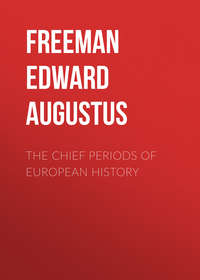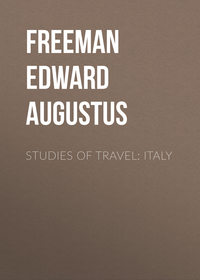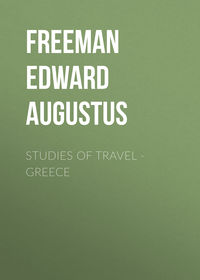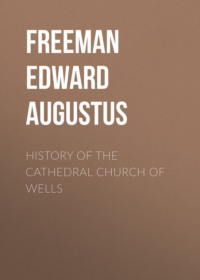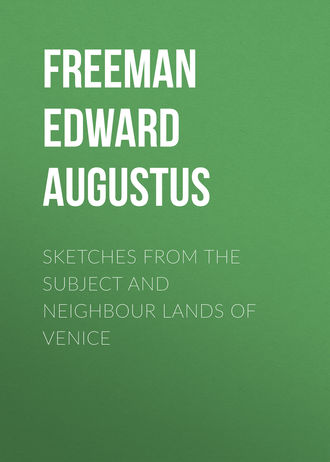 полная версия
полная версияSketches from the Subject and Neighbour Lands of Venice
At Otranto then we have come to the end of one of the great divisions of the European world; it is therefore a fitting point to form a main point of connexion between that division and another. Otranto and its neighbourhood are the only points of the central peninsula from which we can, as a matter of ordinary course, look across into the eastern peninsula. We say as a matter of ordinary course. There are Albanian or Dalmatian heights from which it is said that, in unusually favourable weather, the Garganian peninsula may be descried; so it may be that the Garganian peninsula is favoured back again with occasional glimpses of south-eastern Europe. But a stay of even a few hours at Otranto shows that there south-eastern Europe comes within the gazer's ordinary ken. It is easy to see that it does not so much need good weather to show it as bad weather to hinder it from being shown. Before we reach Otranto, while we are still on the railway, the mountains of Albania rise clearly before our eyes; from the hill of Otranto itself they rise more clearly still. And even to those to whom those heights are no unfamiliar objects from nearer points of view, it is a thrilling and a saddening thought, when we look forth for the first time from a land of which every inch belongs to the free and Christian world, and gaze on the once kindred land that has passed away from freedom and from Christendom. From the soil of free Italy we look on shores which are still left under the barbarian yoke, shores where so many whose fathers were sharers in the European and Christian heritage have fallen away to the creed of the barbarian and to all that that creed brings with it. On the other hand, it is said that there are more favourable moments when it is possible to look from free Italy into free Greece. It is said that, sometimes perhaps Corfu itself, more certainly the smaller islands which lie off it to the west, may be seen from the hill of Otranto. If so, we look out from that one spot of the central peninsula, from that one spot of the general western world, where the Turk can be said to have really ruled, for however short a time, and not simply to have harried. And we look out on that one among the many islands which gird the eastern peninsula, which has gone through many changes and has bowed to many masters, but where alone the Turk has never ruled as a master, but has shown himself only as a momentary besieger.
The Turk then was never lord of Corfu; he was for a while, though only for a very little while, lord of Otranto. The winged lion floated over Corfu while the crescent floated for a season over Otranto. It was therefore perhaps not wholly unfitting that, for another somewhat longer season, the winged lion should float over Corfu and Otranto together. But it was not in his nobler character that the winged lion floated over Otranto. It would have been a worthy exploit indeed, if the arms of Venice, by that time a great Italian power, had driven out the Turk from his first lodgement on Italian soil. But instead of Venice driving the Turk out of Otranto, it was the common belief of the time that it was Venetian intrigue which had let him in. Nay more, if there was any truth in other suspicions of the time, the good old prayer of our forefathers, which prayed for deliverance from "Pope and Turk," might well have been put up by the people of Otranto and all Apulia in the year 1480. Not only the commonwealth of Venice, but the Holy Father himself, Pope Sixtus the Fourth, was believed to be an accomplice in the intrigues which enabled the infidel to establish himself on the shores of Italy. A time came, almost within our own day, when Pope and Turk were really leagued together, and when the Latin Bishop of the Old Rome owed his restoration to his seat to the joint help of the Mussulman Sultan of Constantinople and the Orthodox Tzar of Moscow. But in the fifteenth century we need hardly expect even such a Pope as Sixtus of deliberately bringing the Turk into Italy. His own interests both as priest and as prince were too directly threatened. But it is hard to acquit the Venetian commonwealth, under the dogeship of Giovanni Mocenigo, of risking the lasting interests of all Christendom, and of their own Eastern dominion as part of it, to serve the momentary calls of a petty Italian policy. We even read that Venetian envoys worked on the mind of the Sultan by the argument that it was the part of the new lord of Constantinople to assert his claim to all that the older lords of Constantinople had held east of the Hadriatic. No argument could be more self-destructive in Venetian mouths. If the Turk had inherited the rights of Eastern Cæsar in the Western lands, how cruelly was Venice defrauding him of a large part of the rights of the Eastern Cæsar in his own Eastern lands.
The conquest of Otranto was the last of the conquests of him who rightly stands out in Ottoman history as pre-eminently the Conqueror. The second Mahomet, he who completed the conquest of Christian Asia by the taking of Trebizond, who crowned the work of Ottoman conquest in Europe by the taking of Constantinople, who by the taking of Euboia dealt the heaviest blow to the Venetian power in the Ægæan, who brought under his power, as a gleaning after the vintage, the Frank lordship of Attica and the Greek lordship of Peloponnêsos, in his last days stretched forth his hand to vex Western Europe as he had so long vexed Eastern Europe and what was left of Christian Asia. He was in truth attacking both at the same time; he won Otranto almost at the moment when he was beaten back from Rhodes. Each scene of his warfare illustrates the nature of the Ottoman power at that moment, how it was by the hands of her own apostate sons that Christendom was brought into bondage. Against Rhodes the infidel host was led by a Greek, against Otranto by an Albanian, both renegades or sons of renegades. And under the first Ferdinand of Aragon such was the state of things in the land which had once been ruled by good King William that soldiers of the Neapolitan King were willing to pass into the service of the Turk. Nay, the inhabitants in general seemed ready to believe the Turk's promises and to accept his dominion as likely to be milder than that of their own stranger king. The invader was his own worst enemy. A contemporary writer witnesses that the prisoners taken by Achmet Break-Tooth– such is said to be the meaning of his surname Giédek– pointed out to him that by his cruelties at Otranto he was losing for his master a province which otherwise might have been won with little effort.
But happily things took another turn. Otranto was in the Western world what Kallipolis – the Kallipolis of the Thracian Chersonêsos – had been in the Eastern. It was the first foothold of the barbarian, the gate by which he seemed likely to open his way to the possession of the central peninsula of Europe, as he had by the gate of Kallipolis opened his way to the possession of the eastern peninsula. Otranto was the last of the conquests of the great Conqueror; what if he had been longer-lived? what if the second Bajazet had deserved the name of Thunderbolt like the first? Would the threat of the first Sultan have been carried out, and would the Turk have fed his horse on the high altar of Saint Peter's? The eastern peninsula fell by internal division, and the central peninsula, as his very entrance into it shows, was fully as divided as the eastern. The French conquests presently showed how little prepared Italy was to withstand a vigorous attack, and Mahomet the Conqueror would have been another kind of enemy from Charles the Eighth. But all such dangers were warded off. The Turk still showed himself once and again in northern Italy, but only as a momentary plunderer. Otranto remained his only conquest on Italian ground, and that a conquest held for thirteen months only. Alfonso, who bears so unfavourable a character from other sides, must be at least allowed the merit of winning back the lost city for his father's realm. Otranto, and Otranto alone of Italian cities, belongs to, and heads, the list on which we inscribe the names of Buda and Belgrade and Athens and Sofia, on which it may now inscribe the names of Arta and Larissa, but from which hapless Jôannina and twice-forsaken Parga are still for a while shut out.
It was not therefore till the Turk had been driven out, not until southern Italy had been more thoroughly but not much more lastingly overrun by the armies of France, that Otranto passed for a while under the rule of Venice. The Serene Republic hardly deserved to rule in a city which she had so lately betrayed; the place seems never to have recovered from the frightful blow of the Turkish capture. The town now shows no sign either of the short Venetian occupation or of the shorter Turkish occupation. From the side of military history, this last fact is to be regretted. We must remember that in that day the Ottomans, pressing and hiring into their service the best skill of Europe, were in advance of all other people in all warlike arts. So Guiccardini remarks that the Turks, during their short occupation of Otranto, strengthened the city with works of a kind hitherto unknown in Italy, and which, as he seems to hint, Italian engineers would have done well to copy, but did not. The present fortifications date from the time of Charles the Fifth. Their extent shows at once how far the Otranto of his day had shrunk up within the bounds of the ancient city, and how far again modern Otranto has shrunk up within the walls of the Emperor. It is said that, before the Turkish capture, Otranto numbered twenty-two thousand inhabitants; it has now hardly above a tenth part of that number. As the military importance of the place has passed away, military precautions seemed to have passed away with it; the castle stands free and open; no sentinel hinders the traveller from wandering as he will within its walls. But the traveller will gain little by such wanderings except the look-out over land and sea. The town stands close upon the sea, on a small height with a valley between it and the railway station. It is entered by a gateway of late date, but of some dignity; but it is not much that the frowning entrance leads to. The visitor soon finds that Otranto, which gave its name of old to the surrounding land, which still ranks as a metropolitan city, has sunk to little more than a village. It seems to have had no share in the revived prosperity of the other towns along this coast. Its one object of any importance is the metropolitan church, and this is at once the only monument of the ancient greatness of the place, and also in a strange way the chief memorial of its momentary bondage to the barbarian.
In order thoroughly to take in the position of the great church of Otranto in its second character, as a memorial of bondage and deliverance, it may be well to pass it by for a moment and to go first to the castle, and look out on one of the points of view which it commands. Any local guide will be able to show the traveller the Hill of the Martyrs. It stands at no great distance beyond the town, and is held to mark the site of a pagan temple. There the Turks, after their capture of the city, did as they have done in later times. Some eight or nine hundred of the people of Otranto were massacred. Their bodies lay unburied so long as the Turk kept possession; on the recovery of the city, the bodies of the martyrs, as they were now deemed, were gathered together, and a special chapel was added to the metropolitan church to receive them. There they may still be seen, piled together in cases, with inscriptions telling the story. There are skulls, legs, arms, bones of every part of the human body, some still showing the dents of barbarian weapons, some with barbarian weapons still cleaving to them. There we look on them, ghastly witnesses that, neither in their days nor in ours, is the Æthiopian at all disposed to change his skin or the leopard his spots. What the Turk did at Otranto he has done at Batak; he may, if the freak seizes him, do the like at Jôannina. Only the deeds of Otranto were at least done by the Turk as a mere outside barbarian; he was not licensed to do them by the united voice of Europe. It is only in these latest times that the Turk has been fully authorized, under all the sanctions of so-called international right, to renew at pleasure the deeds of Otranto and of Batak in lands to which Europe has twice promised freedom.
The martyrs of 1480, their sufferings, their honours, have made so deep an impression on the mind of Otranto that the metropolitan basilica has popularly lost its name of Annunziata, and is more commonly spoken of as the church of the martyrs. But the great church of Otranto, the church of the prelate whose style runs as "archiepiscopus Hydrutinus et primas Salentinorum," is a building of deep interest on other grounds. Like so many Italian churches, it is not very attractive without, nor is there anything specially to tarry over in its bell-tower. But even outside we may mark one or two signs of the restoration which the church underwent after its deliverance from the Turk. The west window is of that date, one of those rose-windows to which Italian, and still more Dalmatian, taste clave so long, even when all other mediæval fashions had vanished away. Of the same date is the north door, showing, like the great doors at Benevento, the Primate of the Salentines attended by the bishops and chief abbots of his province. As we go within, our first feeling is one of wonder that so much should have lived through the infidel storm and occupation. But, according to the usual practice of Mussulman conquerors, the head church of the city was turned into a mosque; there was therefore, after the first moment of havoc had passed by, no temptation on the part of the new occupants to damage the essential features of a building which had become a temple of their own worship. It is therefore not wonderful that the main features of the basilica are still there, either untouched or most skilfully restored. Seven arches rise from columns, perhaps of classical date, with capitals, mostly of different kinds of foliage, but one of which brings in human figures, after the type which was so well set in Caracalla's baths. But a more interesting study is supplied by the great crypt, or rather under-church. At Otranto, as in some of its neighbours, the craftsmen who worked below clearly allowed themselves a freer choice of forms in the carving of capitals than they ventured on above ground. The vault of the under-church rests on ranges of slender columns, with heavy abaci and with an amazing variety in the capitals. None perhaps can be called classical; but very few are simply grotesque. The few that are so are found – one does not quite see the reason of the distinction – among the half-columns against the walls. Most of them show various forms of foliage and animal figures; the old law that almost any kind of man, beast, or bird, can be pressed to serve as the volute at the corner of a capital is here most fully carried out. But the further law, that that duty is most worthily discharged by the imperial eagle, can be nowhere better studied than in the Hydrantine under-church. In some capitals again, especially in the columns of the apses, the bird of Cæsar is perched as it were on Byzantine basket-work, clearly showing which Augustus it was to whom the Salentine Primate bowed as his temporal lord. Other capitals again are much simpler, but also savouring of the East; the plain square block has mere carving on the surface. Then, of the columns themselves, some are plain, some are fluted, some are themselves carved out with various patterns. In short a rich and wonderful variety reigns in every feature of the under-church of Otranto.
Our comparison of the columns and capitals has carried us underground; but the really distinctive feature of the basilica of Otranto is above. Other churches of southern Italy have wonderful crypts; none, we may feel sure, has so wonderful a pavement. And here we do wonder that the Turks did not do incomparably more mischief than they did do. Some mischief they did; but the archbishops and canons of Otranto seem – perhaps unavoidably – to have done a great deal more by destroying or covering the rich pavement to make room for the furniture of the church. It would surely be hard to find another example of a pavement whose design is spread over the whole ground-floor of a great church. The pictures are in mosaic, rough mosaic certainly, of the second half of the twelfth century, when Otranto formed part of the Sicilian realm, and when that realm was ruled by William the Bad. Luckily inscriptions in the pavement itself have preserved to us the exact date, and the names of the giver and the artist. One tells us in leonine rimes:
"Ex Ionathi donis per dexteram PantaleonisHoc opus insigne est superans impendia digne.Another stoops to prose: "Humilis servus Ionathas Hydruntinus archieps. jussit hoc op fieri per manus Pantaleonis prb. Anno ab Incarnatione Dni Nri Ihu. Xri MCLXV indictione XIV, regnante Dno nostro W. Rege Magnif." The design of the priest Pantaleon, wrought at the bidding of Archbishop Jonathan in the last year of the first William, is of a most extensive and varied kind. Scriptural scenes and persons, figures which seem purely fanciful, the favourite subject of the signs of the zodiac, all find their place. We meet also with one or two heroes of earlier and later times whom we should hardly have looked for. The main design starts, not far from the west end, with a tree rising from the backs of two elephants. The huge earth-shaking beast, the Lucanian ox, is, it must be remembered, a favourite in southern Italy; he finds a marked place among the sculptures of the great churches of Bari. The tree – one is tempted to see in it the mystic ash of Northern mythology – sends its vast trunk along the central line of the nave, throwing forth its branches, and what we may call their fruit, on either side. Here are strange beasts which may pass either for the fancies of the herald or for the discoveries of the palæontologist; but in the lion with four bodies and a single head we must surely look for a symbolical meaning of some kind. He is balanced, to be sure, by other strange forms, in which two or three heads rise from a single body. Here are figures with musical instruments, here a huntress aiming at a stag; and in the midst of all this, not very far from the west end, we find the figure of "Alexander Rex." To the left we have Noah, making ready to build the ark – the story begins at the beginning, like the building of the Norman fleet in the Bayeux Tapestry. Four figures are cutting down trees, and the patriarch himself is sawing up the wood, with a saw of the type still used in the country. The centre of the pavement is occupied by the zodiac; each month has its befitting work assigned to it according to the latitude of Otranto. Thus June cuts the corn. July threshes it, neither with a modern machine, nor with the feet of primitive oxen, but with the flail which many of us will remember in our youth. August, with his feet in the wine-press, gathers the grapes. December carries a boar, as if for the Yule feast of Queen Philippa's scholars. Each month has its celestial sign attached; but it would seem that the priest Pantaleon was in a hurry in putting together his kalendar, and that he put each of the signs a month in advance. Beyond the zodiac, near the entrance of the choir, and partly covered by its furniture, is a figure, which startles us with the legend "Arturus Rex." If we were to have Alexander and Arthur, why not the rest of the nine worthies? If only a selection, why are the Hebrews defrauded of their representative? – unless indeed Samson, who appears in the form of a mutilated figure, not far from the left of Arthur, has taken the place of the more familiar Joshua, David, and Judas. Here is a witness to the early spread of the Arthurian legends; here, in 1165, within the Sicilian kingdom, the legendary British hero receives a place of honour, alongside of the Macedonian. Nor is this our only witness to the currency in these regions of the tales which had been not so long before spread abroad by Walter Map. By this time, or not long after, the name of Arthur had already found a local habitation on Ætna itself. Among other scriptural pieces in different parts, we find of course Adam and Eve, and Cain and Abel; there is Jonah too, far to the east; and in the eastern part of the north aisle, the imagination of Jonathan or Pantaleon has forestalled somewhat of the Dantesque conception of the Inferno. "Satanas" is vividly drawn, riding on a serpent, and other figures armed with serpents are doing their terrible work in the train of the "duke of that dark place." The whole work is strictly mosaic, and the design, though everywhere rude, is carried out with wonderful spirit. We may indeed rejoice that the hoofs of Turkish horses and the improvements of modern canons have left so much of a work which, even if it stood by itself, it would be worth while going to the end of railways at Otranto to see.
Such is now the one city in which the Turk ever ruled on our side of Hadria. In earlier times we might have passed straight from Otranto to the lands where he still rules, or to the island where he never ruled. But now he who looks out for Otranto on the heights of Albania, and whose objects call him to the nearer neighbourhood of those heights, must go back to Brindisi to find his way to reach them.
FIRST GLIMPSES OF HELLAS
1875 – 1881In our present journey we draw near to the eastern peninsula, to the Hellenic parts of that peninsula, by way of the great island – great as compared with the mass of Greek islands, though small as compared with Sicily or Britain – which keeps guard, as a strictly Hellenic outpost, over a mainland which was and is less purely Hellenic. From Brindisi we sail to Corfu, the elder Korkyra, as distinguished from the black isle of the same name off the Dalmatian shore. In so sailing, we specially feel ourselves to be sailing in the wake of the conquerors who made Corfu an appendage to the Sicilian realm; we are passing between spots on either side which have known both a Norman and Venetian master. But it may be that we may have already drawn near to Greece by another path. It is easy to prolong the voyage which took us from Trieste to Spalato, from Spalato to Cattaro, by a third stage which will take us from Cattaro to Corfu. In this case we may have already studied the Albanian coast, and that with no small pleasure and profit. We may have marked a point not long after we had left Dalmatia behind us, and that where a line may well be drawn. There is a geographical change in the direction of the coast, from the shore of Dalmatia, with its islands and inland seas, its coast-line stretching away to the south-east, to the nearly direct southern line of the shore of Albania. In modern political geography we pass from the dominion of Austria to the dominion of the Turk. In the map of an earlier day, we pass from the all but wholly continuous dominion of the two commonwealths of Venice and Ragusa. In modern ethnology we pass from the Slave under a certain amount of Italian influence to the Albanian under a certain, though smaller, amount of influence, Italian or Greek, according to his local position and his religious creed. In modern religious geography we pass from a land which is wholly Christian, but where the Eastern form of Christianity, though still in the minority, makes itself more deeply felt at every step, to a land where Islam and the two great ancient forms of Christianity are all found side by side. In the geography of earlier times this point marks the frontier of a land intermediate between the barbaric land to the north, with only a few Greek colonies scattered here and there, and the purely Greek lands, the "continuous Hellas," to the south. We find on this western shore of the south-eastern peninsula the same feature which is characteristic of so large a part of the Ægæan and Euxine coasts, both of the south-eastern peninsula itself and of the neighbouring land of Asia. The great mainland is barbarian; the islands and a fringe of sea-coast are Greek. As we draw nearer to the boundary of Greece proper, the Hellenic element is strengthened. Thesprotians, Molossians, Chaonians, were at least capable of becoming Greeks. Epeiros, Ἤπειρος, terra firma, once the vague name of an undefined barbarian region, became the name of a Greek federal commonwealth with definite boundaries. And the character of a barbarian land, fringed with European settlements and looking out on European islands, did not wholly pass away till almost our own day. A few still living men may remember the storming of Prevesa; many can remember the cession – some might call it the betrayal – of Parga. It was only when Parga was yielded to the Turk that this ancient feature of the Illyrian and Epeirot lands passed away. What Corinth had once been Venice was. Corinth first studded that coast with outposts of the civilized world. Venice held those outposts, sadly lessened in number, down to her fall. And the men of Parga deemed, though they were mistaken in the thought, that to the mission of Corinth and Venice England had succeeded.



